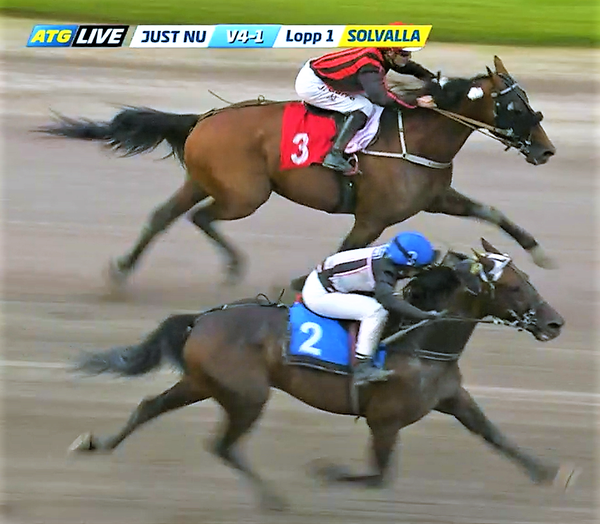For several years now this harness racing writer has followed the Italian-bred trotter Vagabond Bi, a now 9-year-old son of Varenne, who struck my fancy after watching him race several years ago.

With earnings of €213,230 lifetime, this striking black gelding was foaled in Italy but the sold to Swedish interests in February of 2019, is out of the mare Felicity Bi. It was announced that the gelding was being retired this month after a career that saw him grace the winner’s circle 16 times, with 22 second and third place finishing in 86 career starts.
One aspect of this horse which sparked my curiosity is that while he raced in Italy with shoes on, 29 starts to be exact, the good majority (33) of his 57 races in Scandinavia, he either had his shoes pulled in front, or in most cases all the way around. Of those 33 occasions that Vagabond Bi raced sans shoes; 24 times he raced barefoot, and nine times he raced with only hind shoes.
Of the starts he raced barefoot, he won three times, with three second and third place finishes, and finished first through fifth a total of 14 times. Likewise, when racing with hind plates only, he had one win and eight seconds in nine starts shod in that fashion. He competed in four monte races during his career, all with hind shoes only, and had a first, second, and a third in those events.
Being somewhat of a purist, I always think it’s great when horses race barefoot, and so I began researching horses who race barefoot verses those who do not/have not, and I found some interesting information.

According to an article that appeared in the online journal Hoofblog, which cites research performed at the University of Agricultural Sciences (SLUK) at Uppsala, Sweden, “barefoot horses raced an average of 0.7 seconds faster per kilometer than horses shod on both the hind and the front feet. The difference was a little smaller (0.3 seconds per kilometer) if they were without shoes only on the hind or front feet, but they still raced faster than if they had shoes on all four hooves.”
Another entry in this same article surmised that “the times from just over 75,000 starts and 5,000 horses were included. The research showed that horses raced statistically faster when barefoot. The practice is not without risk…since data on the all-barefoot horses showed an increased tendency to break stride, causing elimination from the race,” and that “the rick potential of breaking gait and disqualification was then analyzed in over 111,000 starts, reflecting the performance of 6,400 horses. Those results showed that the breaking risks increased by 15 to 35% if the horses competed fully barefoot.”
While it is well known that far more horses will race either completely barefoot or half-barefoot over European surfaces, many times horsemen in the United States will pull their charges shoes—we often see this for big trot races at both The Meadowlands and at Lexington’s Red Mile. Horsemen in this country, however, rarely pull shoes over half-mile raceways and nearly never at county fair venues.
Another study, this one on locomotion and trotting speeds, cited from the Wiley Online Library on May 3, 2020, in the Animal Science Journal, states that “findings for high-speed trotting remains to be investigated, but if the 8% to 10% reduction in body vertical displacement persists at high speed, there could be a positive impact on racing performance.
Overall, these locomotion studies, and the fact that shoes increase the weight carried, indicate that performance (namely velocity) could be improved without shoes.” The authors (G. Lindgren, E. Bongcam-Rudloff, and A. Jansson) also contend that “The conformation and ‘quality’ of the hoof, such as tissue volume, composition, and structure, may not always be optimal for competing unshod, which could result in high wear and tear and most likely also high sole and frog pressure…competing may compromise horse welfare and have a negative impact on performance.”
So, for Vagabond Bi, the times he raced with hind shoes only, he obviously performed well, and better, statistically, than he did with all four plates removed. This also brings to mind Captain Corey’s performance a few years ago in the $1 million Hambletonian, when Ake Svanstedt raced the winner in the final heat sans all four shoes. Svanstedt is just one of successful many European trainers who have come stateside to train and have used this technique to their advantage. Or could it be that the track was just in such great shape in 2019, that it was a bit kinder to Captain Corey’s feet, and that factor also played into the equation?
Whatever the case, the question of racing trotters with or without shoes will likely continue for decades to come. One advantage that comes up when researching Scandinavian race records, is that when a horse does race without shoes, either all the way around or up front/behind, that notation is indicated on the horse’s race line. This becomes a vital piece of information when analyzing a horse’s performance record and would be advantageous to have recorded on those of the diagonal gait records in this country as well.
by Kimberly Rinker, for Harnesslink

 USA
USA Canada
Canada Australia
Australia New Zealand
New Zealand Europe
Europe UK / IRE
UK / IRE



